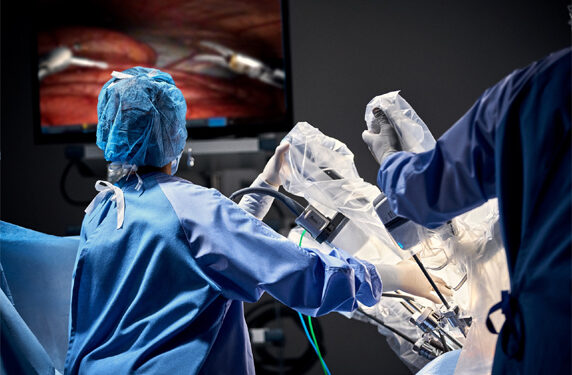- Several other hospitals were reluctant to perform this surgery considering the patient’s high BMI, age and other complications
- The surgery was led by Dr. Nitin Singhal, Director of Surgical Oncology, Sterling Hospital, Ahmedabad with the help of advanced robotic – assisted surgery technology, the da Vinci
- The team of doctors guided me through the severity of my condition and emphasized the importance of undergoing robotic-assisted surgery for better outcomes, and leading a quality life ahead: 74-year-old female patient
NE HEALTH BUREAU
AHMEDABAD, MAY 31
Doctors at Sterling Hospital, Ahmedabad on Friday announced that they had recently successfully treated a 74-year-old female patient suffering from excessive vaginal bleeding due to endometrial cancer by performing a unique robotic-assisted surgery. The surgery was led by Dr. Nitin Singhal, Director of Surgical Oncology, Sterling Hospital, Ahmedabad with the help of advanced robotic – assisted surgery technology, the da Vinci.
The patient was diagnosed with stage 1 endometrial cancer three years back and has been suffering from vaginal bleeding since then. Given the patient’s obesity, weighing 135kg and having a BMI over 54, several doctors were reluctant to perform any surgical procedures, considering the complications that may arise. Despite consulting with numerous surgeons, the patient was repeatedly advised to lose weight. She sought treatment at various hospitals and underwent radiation therapy, but found no relief.
Her journey to recovery began when she visited Sterling Hospital in Ahmedabad and consulted with Dr. Nitin Singhal. After a thorough examination, it was discovered that her endometrial cancer had spread to the cervix and had progressed to stage 3.
Commenting on the complexity of the case, Dr. Nitin Singhal explained, “There were numerous challenges involved in advancing her treatment. Primarily, her high BMI and a room air saturation rate of 92% made any surgical procedure risky. An open surgery was impossible due to the considerable thickness of her subcutaneous fat, which was around 10-12 cm. Laparoscopy was also not a viable option because the instrument reach was insufficient to effectively manipulate the affected area. Additionally, the patient had previously undergone surgery for an umbilical hernia, making adhesiolysis extremely difficult with conventional methods. Therefore, robotic-assisted surgery by using da Vinci was the only feasible option, offering the precision and control necessary to navigate these complexities safely.”
Before proceeding with robotic-assisted surgery, the patient underwent chest physiotherapy for three to four days to optimize her condition.
Dr. Singhal further elaborated, “Operating on obese patients presents significant challenges, such as the risk of blood vessel slippage, which can easily lead to blood loss. The 3D visualization and dexterity offered by da Vinci robotic technology ensured minimal blood loss during the surgical procedure. Any other procedure would have necessitated more incisions, increasing the risk of complications like wound infections, hernia development, and paralytic ileus. The minimally invasive nature of robotic-assisted surgery facilitated a quicker recovery with improved wound healing.”
The robotic system comprises small, flexible instruments that can maneuver with greater dexterity than the human hand, accompanied by a high-definition 3D vision system for enhanced visualization. With heightened precision, minimal blood loss and scarring, robotic-assisted surgery offers numerous benefits to the patients as well as the doctors.
Expressing her gratitude, the 74-year-old patient said: “I can’t thank Dr. Nitin enough for helping me recover from this three-year long suffering and pain. The team of doctors guided me through the severity of my condition and emphasized the importance of undergoing robotic-assisted surgery for better outcomes, and leading a quality life ahead. Without the help of these advanced technologies and the expertise of these doctors, I wouldn’t have been able to recover from this disease.”









